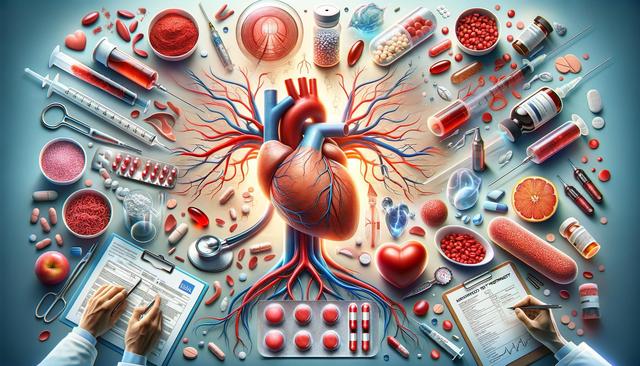Understanding Treatments That May Help Break Down Blood Clots and Unclog Arteries
Artery blockages can affect heart health, but several treatments may help manage the condition. From lifestyle changes and medications to advanced procedures, this guide explains common options and what to expect. Learn how early diagnosis and care can support long-term cardiovascular wellness. Always consult your doctor for guidance.

Lifestyle Modifications: The First Line of Defense
Managing artery blockages often begins with addressing lifestyle factors. These changes not only help reduce existing risk but can also prevent further clot formation. A heart-healthy lifestyle supports better blood circulation and reduces the buildup of plaque in the arteries.
Key lifestyle modifications include:
- Adopting a diet low in saturated fats and added sugars, and rich in fruits, vegetables, whole grains, and lean proteins
- Engaging in regular physical activity, such as walking, swimming, or cycling for at least 30 minutes most days
- Quitting smoking and avoiding exposure to secondhand smoke
- Limiting alcohol intake to moderate levels as advised by healthcare professionals
These changes can help reduce blood pressure, lower cholesterol, and improve overall vascular function. While lifestyle by itself might not be enough to dissolve blood clots or remove significant blockages, it lays the groundwork for more effective outcomes when combined with other treatments.
Medications That Support Blood Flow and Clot Management
Several types of medications are commonly prescribed to address blood clots and arterial blockages. These therapies work by thinning the blood, reducing clot formation, or targeting plaque buildup.
Common medications include:
- Antiplatelet drugs: These prevent platelets from clumping together, which helps reduce clot formation in the arteries.
- Anticoagulants: Also known as blood thinners, these medications help prevent new clots and keep existing ones from growing.
- Statins: Used to lower cholesterol, statins can also stabilize existing plaque, reducing the risk of rupture and clot formation.
- Thrombolytics: In certain emergency situations, these drugs are used to actively dissolve clots in arteries and veins.
Medication regimens are often tailored to individual needs, based on the severity and location of the blockage, as well as overall health status. Regular follow-up with healthcare providers ensures that treatments remain effective and safe.
Minimally Invasive Procedures to Restore Blood Flow
When medications and lifestyle changes are not sufficient, minimally invasive procedures may be necessary to treat arterial blockages. These techniques aim to restore proper blood flow and prevent complications such as heart attacks or strokes.
Two commonly used procedures include:
- Angioplasty: A catheter with a small balloon is inserted into the blocked artery and inflated to open the vessel.
- Stenting: Frequently performed alongside angioplasty, a stent (a small metal mesh tube) is placed in the artery to keep it open long-term.
These procedures are typically performed in a hospital setting and involve short recovery times. While not suitable for all cases, they can be effective for those with significant narrowing or recurring symptoms despite initial treatment efforts.
Advanced Surgical Options for Severe Cases
In situations where blockages are extensive or located in critical arteries, more invasive surgical interventions may be recommended. These procedures are designed to bypass or remove obstructions, improving blood flow to vital organs.
Common surgical treatments include:
- Coronary artery bypass grafting (CABG): A surgical technique where blood vessels from other parts of the body are used to reroute blood around a blocked artery.
- Carotid endarterectomy: A procedure to remove plaque from the carotid arteries in the neck, which can reduce the risk of stroke.
- Peripheral artery bypass: Used to treat blockages in the legs or arms by creating an alternate path around the narrowed artery.
Surgical treatments often require longer recovery periods but can be life-saving in certain cases. The decision to undergo surgery is based on multiple factors including the location of the blockage, the patient’s overall health, and the potential benefits versus risks.
The Role of Early Detection and Regular Monitoring
Early diagnosis plays a crucial role in successfully managing artery blockages and blood clots. When detected early, many conditions can be treated more effectively with less invasive approaches. Regular check-ups and monitoring help ensure that any changes in cardiovascular health are addressed promptly.
Diagnostic tools commonly used include:
- Ultrasound and Doppler imaging to assess blood flow
- CT angiography or MRI for detailed visualization of arteries
- Blood tests to monitor cholesterol levels, clotting factors, and inflammatory markers
Patients at risk—such as those with diabetes, high blood pressure, or a family history of heart disease—should work closely with their healthcare provider to establish a monitoring routine. Personalized plans that include lifestyle, medication, and possible interventions offer a comprehensive strategy for long-term health.
Conclusion: Taking a Comprehensive Approach to Artery Health
Managing blood clots and arterial blockages involves a multi-level approach that includes lifestyle changes, medication, minimally invasive procedures, and sometimes surgery. Each treatment option offers unique benefits depending on the individual’s condition and risk factors. Early detection and consistent medical care are essential for achieving the best outcomes. By staying informed and proactive, individuals can support their cardiovascular health and reduce the risk of serious complications. Always consult a healthcare provider to determine the most appropriate treatment plan for your needs.